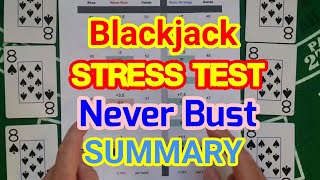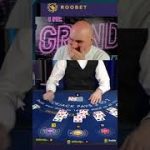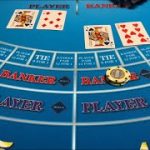Blackjack Strategy Video Source & Information:
I made the #1 shoe in this series “unpublic.” If you are a glutton for punishment and wish to see it, pm me.
—–
Finally completed this procedurally painful series. One thing we learned in absolution, it is much easier to run two carbon copied shoes in series than in parallel.
Be back in September 2018.
Have a great summer!
Source: YouTube








I thought with basic statagy co inside with your bets and counting??? Would that further boost the out comes in moolah???
Can you do another never against basic
I think proper test would be with one shoe for both players NB and BS playing same time
Dear Mr 8♠,
I am fascinated by the amount of time and effort you have put into making these videos! Setting up the boots alone would be a daunting task, but then you spend an hour or so creating a video comparing the performance of two identical boots in response to two different blackjack strategies. To me, that is just amazing, really.
I just finished watching all the videos in this Stress Test, comparing Never Bust to Basic Strategy, and decided that you might be interested in my constructive criticism of your methodology.
One affect of the way you are doing your testing is that the moment the boots diverge, you have introduced another random element into the study. I realize that by increasing the number of hands played, any discrepancies in the results are minimized, but I think a more interesting way to study, compare, and contrast two different systems might be to simply compare them in identical situations. For example, you could
set the dealer's showing card sequentially to A, K, Q, J, 10, 9…. and set the player's cards to AA, KK, QQ, JJ, 10 10…. and test each set in order against the all the permutations of cards in the dealer's hand. There are 13 × 51 = 663 possible pairings, although in the players hand, many will be redundant. For the player 4 10 is the same as 10 4. But since betting changes depending on the dealer's shown card, the player's combination must be tested against both 10 4 and 4 10, depending on which is showing.
To test all combinations against all combinations (not strictly needed, but shows the relative magnitude of the test), would be about 663 × 663 = ~ 440,000.
That's a big number, far larger than your 7 shoe test, which only yielded about 350 "tests", if we consider each hand as a separate test.
To test nearly half a million permutations is going to require computing power, and a coder who is familiar with, or can be taught, the ramifications of each possible action the player and dealer may take. I'm pretty sure it was through the use of computers that Basic Strategy was developed, and it seems like a natural use for the big dumb
machines. Set one to work, just grinding away on every possible scenario, and 440,000 tests later, we'd have a definitive answer, not subject to the randomness that the kind of sporadic coverage of the problem space that your method introduces. There may be little or no difference in the results, but then you never know! The wide swings in your data boot to boot suggests that your sample size of 350 tests may be far too small.
Just food for thought.
The reason a lot of people in the casinos are holding on 12s vs dealer 12 -16 is because of the "wizard of odds" simplified "basic strategy" which just simplifies things. i imagine tons of people use it! It is the dumbed down version of the full strategy and is good… only giving the house a small extra edge over the full strategy. Well worth using the simplified version because most people are very simple and not analytical and have not memorized the full basic strategy. Overall i think simplified strategy has made better blackjack players in the casinos.
Oh boy this garbage does not work. Only catd counting can beat blackjack and even If you card count you will still lose 49 percent of the time, maybe more of your game is not perfect
Thanks for performing this test, but I did notice that you loose more double downs than you win, so you should also see if doubling down is worth it, because your unit count would have been much higher for the never bust if you havent gave all those units away on double down.
Try playing again without double down or splits so its straight up one for one black jack, then see what that unit count is.
Thanks for all the time you put in ! I enjoy learning as much as I can . I am going to the boat soon , I'm sure you will increase my winnings! Thank from the Bake
Thank you so much for your work!! I am doing some of my own research and I am a bif fan of the no0bust idea, but not no0bust every time you hit a 12. Let me explain when I will use the no0bust strategy and when I won;t and why (this is just my opinion, take it for what it is worth). Let's say you have a hard 15 or 16, I know basic strategy says to hit, but I think this could be incorrect at times (mo disrespect to the MIT geniuses!!!. With a hard 16, you have 6 cards which can help you (A,2,3,4,5,) and 9 cards which will bust you. With a 5 to 8 raio, that means you have a 61.5% (8 bad cards/13 in a suit) of busiing, never giving you a chance to win. I don't like those odds. I would rather give myself a chance to win by letting the dealer bust. Same thing with the hard 15. 5 cards will help your (2,3,4,,5,6) and 8 will hurt you (the Ace would give you a 16, so it would be a bad card in this case). The only time to hit with a hard 15 or 16 is against an Ace because the house has too big an advantage at that point.
You also hit on a hard 12 many times using basic strategy. I believe no bust should do the same thing. Again, 9 cards cannot bust you (A-9) and 4 cards will bust you (10,J,Q,K). That give you a 69% chance to improve your hand. I would like to see a test run using this idea when the dealer has a 3 up along with a 2 (play everything else as your would with basic strategy).
One last thing: I don't always like to split aces with everything up to a 10.also, specifically if I am on a losing streak (2 or more hands). Technically, I know this is not correct. With an ace, you are way ahead of a 10 because any card you pull will. My reason for not splitting is strictly defensive. When you spleit aces, you get one card and that's it. When you don't split, you can redraw if you get a bad card. I would rather only lose 1 hand (especially in a negative progressive system) than risk losing two hands (I like the lower risk approach when I am running cold). Not against all hands, however. You would still split if the dealer has a 5,6, or 7 as their up card. All other hands, do not split.
Recap: do not hit a hard 15 or 16 against anything except an Ace. Let the dealer try to bust. Hit a hard 12 against a dealer's upcard of 2 or 3. All other hands play like you would with basic strategy. Finally, do not split aces unless you are up against a dealer's upcard of 5,6, or 7 (again, when you have lost two hands in a row or more). Can you rus some stress tests with these ideas and see what you come up with?
Great videos, I would not stress to much about arbitrary results from your methodology or random faux E intellects that aren't really. Most people understand the why of basic strategy and why it's superior to a no bust system.